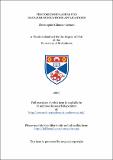Files in this item
Femtosecond lasers for datacommunications applications
Item metadata
| dc.contributor.advisor | Sibbett, Wilson | |
| dc.contributor.author | Leburn, Christopher Gilmour | |
| dc.coverage.spatial | viii, 135 p. | en_US |
| dc.date.accessioned | 2020-06-08T12:43:14Z | |
| dc.date.available | 2020-06-08T12:43:14Z | |
| dc.date.issued | 2005-11-30 | |
| dc.identifier.uri | https://hdl.handle.net/10023/20055 | |
| dc.description.abstract | The work presented in this thesis details the development of all-solid-state ultrashort pulsed lasers suitable for datacommunications applications at either 1300nm or 1550nm. This is achieved through the design and construction of three different types of laser system based on the gain materials Cr⁴⁺:forsterite (chromium-doped magnesium iron silicate) and Cr⁴⁺:YAG (chromium-doped yttrium aluminium garnet). A Cr⁴⁺:forsterite based system is the first laser that is presented. This configuration utilises a relatively novel GalnNAs semiconductor device to initiate the generation of 130fs pulses around 1300nm. Although GalnNAs devices have previously been used to generate pulses of light in the picosecond domain, this is the first time ultrashort pulses have been achieved in the femtosecond domain. As such, it has been possible to use the results from this laser system to further the understanding of various dynamics of GalnNAs devices. An SBR mode-locked Cr⁴⁺:YAG laser system introduces the concept of Femtosecond pulse generation around 1550nm. This is done in order to lay the necessary foundations for understanding the motivation and physics behind high pulse repetition frequency (prf) all-solid state femtosecond lasers suitable for datacommunications applications. Details are then given for the construction and operation of a simple 3-element Cr⁴⁺:YAG laser that generates 70fs pulses at a prf greater than 4GHz. The success of this system leads to the development of a compact and robust engineered prototype with a footprint of 215x 106mm². Integration of the high prf laser systems into novel optical time division multiplexing/wavelength division multiplexing (OTDM/WDM) based assessments prove successful with the demonstration of a datacommunications system capable of generating 1.36Tb/s. This still remains to be the only system capable of achieving such a high capacity from a single source and demonstrates the ongoing success of femtosecond lasers through continued research and development. | en_US |
| dc.language.iso | en | en_US |
| dc.publisher | University of St Andrews | |
| dc.subject.lcc | TK5105.L4 | |
| dc.subject.lcsh | Laser pulses, Ultrashort | en |
| dc.subject.lcsh | Data transmission systems | en |
| dc.title | Femtosecond lasers for datacommunications applications | en_US |
| dc.type | Thesis | en_US |
| dc.type.qualificationlevel | Doctoral | en_US |
| dc.type.qualificationname | PhD Doctor of Philosophy | en_US |
| dc.publisher.institution | The University of St Andrews | en_US |
This item appears in the following Collection(s)
Items in the St Andrews Research Repository are protected by copyright, with all rights reserved, unless otherwise indicated.

